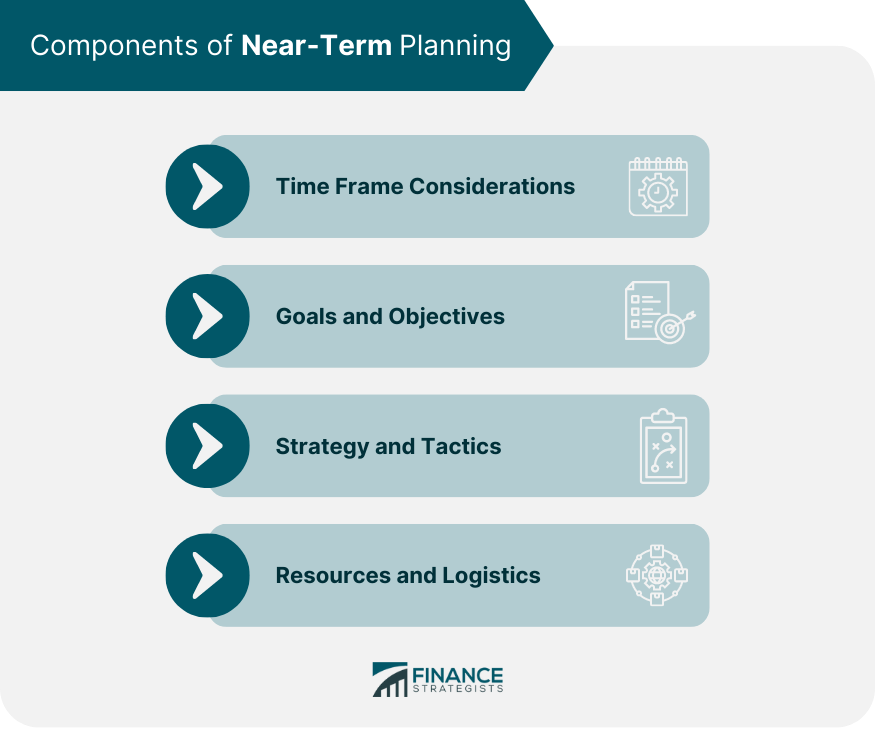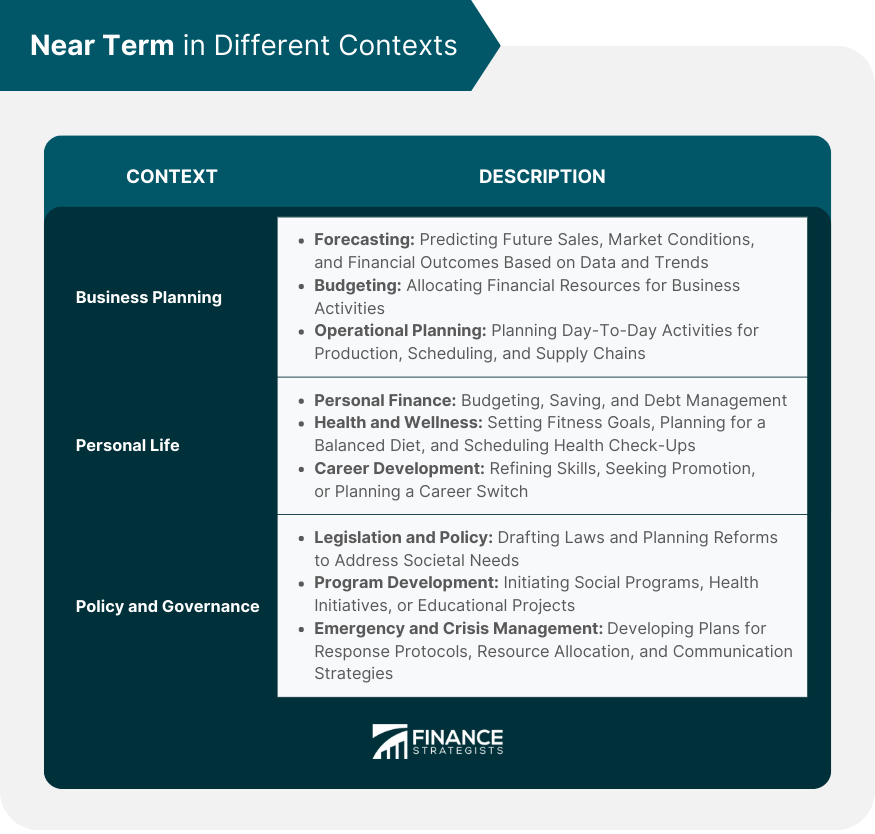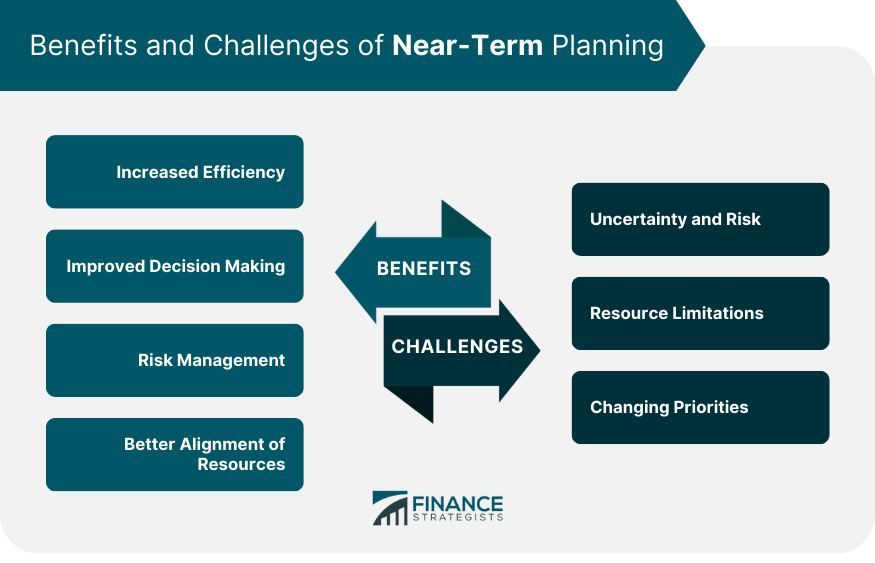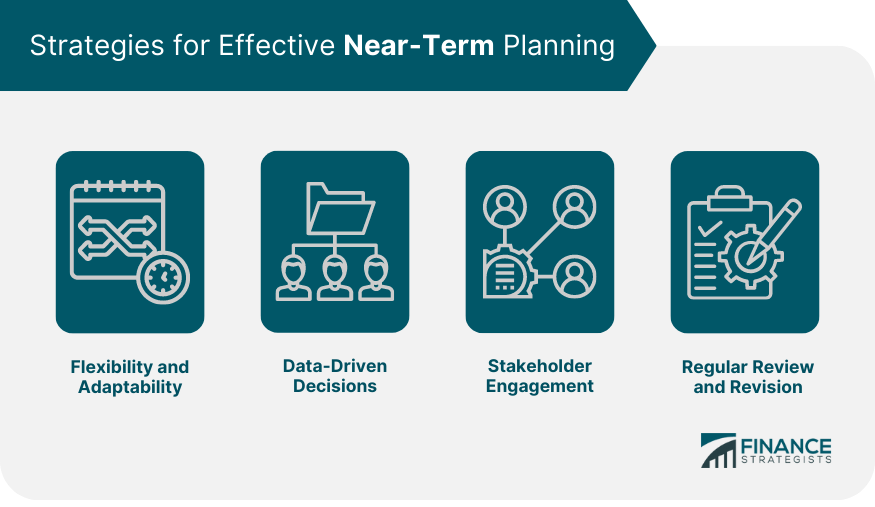The concept of the "near term" often varies across contexts, but it generally refers to a relatively short period, typically within the next few months to a year. It's a timeframe that, while immediate, allows for planning, preparation, and proactive decision-making. The near term bridges the gap between what is happening now and the long-term future, serving as a crucial period for realizing both immediate objectives and setting the stage for more distant goals. Near-term planning is paramount for both individuals and organizations. It's a pivotal process that steers actions and decisions in the short run while also laying the groundwork for long-term visions. Near-term planning helps align resources, manage risks, and capitalize on opportunities, thus ensuring efficiency and effectiveness in various facets of life and business. The first component of near-term planning involves establishing an appropriate timeframe. While "near term" generally implies a short period, the exact duration can vary depending on the context. For instance, a business may view the near term as the upcoming fiscal quarter, while an individual may consider it as the next month. Defining the near term ensures everyone involved has a shared understanding of the timeline for planning and action. Setting clear and specific goals is a crucial aspect of near-term planning. These goals provide a direction for the plan and serve as benchmarks for measuring progress. Objectives should be SMART: Specific, Measurable, Achievable, Relevant, and Time-bound. They should clearly define what needs to be accomplished within the near term. Once goals are established, it's vital to outline the strategies and tactics that will be used to achieve them. Strategies provide the overall approach, while tactics detail the specific actions required. In near-term planning, strategies and tactics should be practical and executable within the defined timeframe. Effective near-term planning also involves considering the resources and logistics necessary to carry out the plan. Resources can include finances, personnel, and tools, while logistics involve the coordination and execution of the plan. Identifying these elements in advance ensures smooth execution and helps anticipate potential challenges. Near-term planning in business often starts with forecasting—predicting future sales, market conditions, and financial outcomes based on current data and trends. Effective forecasting can help a business prepare for the near future, enabling it to allocate resources efficiently and respond to market changes proactively. Budgeting is another crucial aspect of near-term business planning. It involves allocating financial resources for various business activities in the near term. Budgeting ensures financial sustainability, promotes efficiency, and allows a business to pursue its near-term goals without overextending its resources. Operational planning is the process of planning the day-to-day activities that produce goods or services. In the near term, operational planning might involve scheduling shifts, organizing workflows, or managing supply chains. Good operational planning can enhance productivity, minimize waste, and ensure the business can meet its near-term objectives. In personal finance, near-term planning might involve budgeting, saving for an upcoming expenditure, or paying down debt. It's about managing one's finances effectively to meet near-term needs and prepare for future financial health. In the context of health and wellness, near-term planning could include setting fitness goals, planning for a balanced diet, or scheduling regular health check-ups. Such planning can contribute to improved physical health, mental well-being, and overall quality of life in the near term. In career development, near-term planning may involve refining skills for a current job, seeking a promotion, or planning a career switch. By setting and achieving near-term goals, individuals can make significant strides toward their ultimate career aspirations. In the realm of policy and governance, near-term planning is crucial. Policymakers may use it to draft legislation addressing immediate societal needs or plan reforms for the upcoming legislative session. Near-term planning helps ensure policies are timely, relevant, and responsive to the needs of the populace. Government entities or non-profits may use near-term planning for program development, such as initiating social programs, health initiatives, or educational projects. This planning ensures that these programs are well-structured, adequately resourced, and capable of meeting their objectives within a given timeframe. Near-term planning is particularly important in emergency and crisis management. In anticipation of potential crises, agencies can develop near-term plans that outline immediate response protocols, resource allocation, and communication strategies. Such preparedness can significantly mitigate the impact of emergencies when they occur. By clearly outlining goals, strategies, and resources, near term planning helps individuals and organizations execute tasks more efficiently. It minimizes confusion, reduces wasted effort, and promotes better use of time and resources. Near-term planning enhances decision-making processes by providing a clear framework of goals and strategies. Decisions can be made quickly and confidently, as they are guided by a well-defined plan. Through near-term planning, potential risks can be identified and mitigated before they become significant issues. It allows for proactive risk management, which can prevent problems and ensure smoother execution of plans. Near-term planning helps ensure resources are well-aligned with objectives. Whether it's personnel, finances, or time, proper planning ensures that resources are used optimally, contributing to the achievement of goals. While near-term planning helps manage risks, it also faces the challenge of uncertainty. Unpredictable events can disrupt even the best-laid plans, necessitating quick adaptations. Resource constraints can pose a significant challenge to near-term planning. Limited resources must be allocated judiciously, and it may be difficult to execute plans fully if resources run short. In a rapidly changing world, priorities can shift quickly. Near-term plans may need to be revised or discarded altogether if they no longer align with shifting objectives or circumstances. Flexibility and adaptability are vital for successful near-term planning. While a plan provides a guide, it's essential to be ready to adjust as circumstances change. Decisions in near-term planning should be grounded in solid data. This approach ensures that plans are realistic, achievable, and responsive to current conditions and trends. Engaging stakeholders in the planning process can enhance the effectiveness of near-term plans. Stakeholders can provide valuable insights, foster buy-in, and contribute to successful plan implementation. Lastly, near-term plans should be regularly reviewed and revised as necessary. Regular reviews ensure that plans remain relevant and effective, even as circumstances change. By revisiting and adjusting plans, you can stay on course toward your near-term goals. Near-term planning plays a crucial role in various contexts, including business, personal life, policy, and governance. It provides a timeframe for planning, preparation, and proactive decision-making, bridging the gap between the present and long-term future goals. Near-term planning involves components such as establishing an appropriate timeframe, setting clear goals and objectives, outlining strategies and tactics, and considering necessary resources and logistics. It offers numerous benefits, including increased efficiency, improved decision-making, risk management, and better alignment of resources. However, near-term planning also faces challenges such as uncertainty, resource limitations, and changing priorities. To ensure effective near-term planning, strategies such as flexibility and adaptability, data-driven decisions, stakeholder engagement, and regular review and revision are essential. By employing these strategies, individuals and organizations can navigate the near term successfully and work towards achieving their objectives.What Is Near Term?
Components of Near-Term Planning
Time Frame Considerations
Goals and Objectives
Strategy and Tactics
Resources and Logistics

Near Term in Different Contexts
Near Term in Business Planning
Forecasting
Budgeting
Operational Planning
Near Term in Personal Life
Personal Finance
Health and Wellness
Career Development
Near Term in Policy and Governance
Legislation and Policy
Program Development
Emergency and Crisis Management

Benefits of Near-Term Planning
Increased Efficiency
Improved Decision-Making
Risk Management
Better Alignment of Resources
Challenges in Near-Term Planning
Uncertainty and Risk
Resource Limitations
Changing Priorities

Strategies for Effective Near-Term Planning
Flexibility and Adaptability
Data-Driven Decisions
Stakeholder Engagement
Regular Review and Revision

Final Thoughts
Near Term FAQs
The term "near term" generally refers to a relatively short period, typically within the next few months to a year. The exact duration can vary depending on the context.
Near-term planning is important because it helps align resources, manage risks, and capitalize on opportunities. It's a critical process for realizing immediate objectives and setting the stage for long-term goals.
Key components of near-term planning include defining the timeframe, setting goals and objectives, devising strategies and tactics, and considering the resources and logistics necessary for execution.
Challenges in near-term planning include dealing with uncertainty and risk, limitations of resources, and rapidly changing priorities.
Strategies for effective near-term planning include maintaining flexibility and adaptability, making data-driven decisions, engaging stakeholders, and regularly reviewing and revising plans.
True Tamplin is a published author, public speaker, CEO of UpDigital, and founder of Finance Strategists.
True is a Certified Educator in Personal Finance (CEPF®), author of The Handy Financial Ratios Guide, a member of the Society for Advancing Business Editing and Writing, contributes to his financial education site, Finance Strategists, and has spoken to various financial communities such as the CFA Institute, as well as university students like his Alma mater, Biola University, where he received a bachelor of science in business and data analytics.
To learn more about True, visit his personal website or view his author profiles on Amazon, Nasdaq and Forbes.











